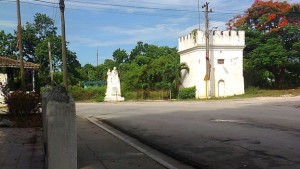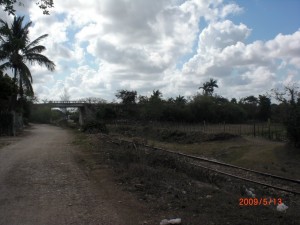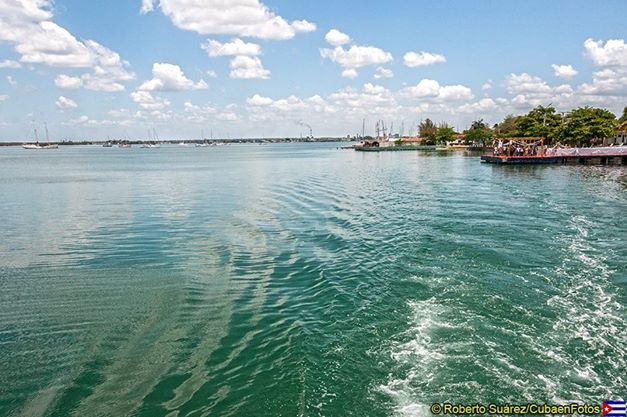QUIEN SE RECUERDA DEL PUEBLO DE ENCRUCIJADA, VILLA CLARA..?
Por Jose Gabriel Berrenechea, Cuba.
Encrucijada es un pueblo mediano del norte de Villa Clara, sin agua potable y sin alcantarillado. La presencia de hidrantes en algunas esquinas atestigua que en algún momento tuvimos acueducto. Mientras la importante cantidad de bustos, monumentos y tarjas conmemorativas apunta a que en ese nebuloso tiempo anterior también teníamos civismo.
Habitamos en este pueblo poco más de doce mil personas, pero también unos cuantos cientos de cerdos, que los vecinos crían en sus patios. En las ardientes tardes de verano sus inmundicias les dan al pueblo su olor característico.
En esos otros tiempos cívicos de que hablábamos, Encrucijada era llamado el “París chiquito”. No habitaban cerdos en su área urbana, y la sucursal del Banco Pujol atendía a unos 1.500 campesinos y pequeños propietarios comerciales. Hoy las cuatro cuadras de comercios, que hasta pagaban un custodio propio, han desaparecido.
Por estos días las ruinas del Hotel Alvaré cumplen cincuenta años. Cierto comisionado municipal decidió en 1964 que la Revolución iba a levantar un hotel “más mejor todavía”, por lo que al día siguiente se comenzó a derribar esta joya arquitectónica. Una súbita amenaza imperialista, de las tantas, detuvo las obras de la nueva edificación. Medio siglo después aquel cascarón incompleto sigue en pie, mientras el hospitalito, con solo siete años de levantado, muestra una cuestionable capacidad para durar lo mismo.
A Encrucijada lo cruza un arroyo, seco la mayor parte del año pues con el aumento en la molida de sus centrales, hace un siglo, crucificaron el bosque virgen de los aledaños, por donde cimarroneara alrededor de 1870 el Esteban Montejo de Miguel Barnet. El arroyo, no obstante, a ratos sorprende.
Hoy, el “Paris chiquito” es un pueblo muy alejado de lo que fue. Sus mejores hijos se han marchado a un ritmo alucinante.
En los años setenta, recuerdo las crecidas del “río” y a mi hermano con el agua a la rodilla, que me llevaba en brazos a la seguridad de la casa de mi madrina Petra. La misma que protagoniza el dicho local “va a llover más que el día en que se casaron Petra y Pellejero”. La construcción de micropresas en su curso superior acabó con esos desmadres.
La realidad, sin embargo, ha superado a la capacidad planificadora del marxismo-leninismo, por lo que todavía el arroyo suele transformarse en un río de hasta 80 metros de orilla a orilla. Desde la azotea de la biblioteca municipal, antes Casino Español, se divisan las chimeneas de cuatro centrales: Constancia, Carmita, Macagua y Santa Lutgarda. Otros dos serían visibles si quitáramos de en medio los Mogotes del Purio: la del central de idéntico nombre, y la del Nazábal.
He hablado de chimeneas y no de centrales, porque de los seis solo muelen todavía dos. A los restantes le robaron la maquinaria y hasta la techumbre, como antes pasara con los carriles de vía estrecha que cubrían de cuadrículas toda la vasta zona cañera.
En mi infancia y adolescencia la zafra marcaba los ritmos, creaba toda una cultura, la del azúcar. No solo porque los pitos de los centrales que llamaban a cada uno de los tres turnos de trabajo de ocho horas regularan el tiempo. Tampoco porque en la madrugada los trenes cargados de caña me iniciaran en los misterios de la distancia. Más bien era toda una cultura industrial, mecánica y a la vez atenta al clima y a la tierra, que lo llenaba todo y a todos, dotando a los encrucijadenses de una amplitud de horizontes que ha desaparecido.
Al día de hoy Encrucijada es un pueblo muy alejado de lo que fue. Del que sus mejores hijos se han marchado a un ritmo alucinante, hacia la Habana o Barcelona, pero sobre todo a Miami y en cigarretas, por las muy vigiladas costas del municipio. Muchos podrían haber hecho sus vidas aquí, pero puestos ante la encrucijada de nuestra realidad, tomaron el camino de marcharse.
14TMedio/Jose Gabriel Barrenechea, Cuba/InternetPhotos/www.thecubanhistory.com
The Cuban History, Hollywood.
Arnoldo Varona, Editor.
WHO REMEMBERS THE TOWN OF ENCRUCIJADA IN VILLA CLARA ..?.
By Jose Gabriel Barrenechea, Cuba.
Encrucijada is a medium sized town in the north of Villa Clara, no running water and no sewage. The presence of hydrants in some corners testified that at some point had aqueduct. While the large number of busts, monuments and commemorative plaques suggests that in that nebulous time we also had previous citizenship.
We live in this town just over twelve thousand people, but also a few hundred pigs reared neighbors in their yards. In the hot summer afternoons their uncleanness give the town its characteristic odor.
We live in this town just over twelve thousand people, but also a few hundred pigs reared neighbors in their yards. In the hot summer afternoons their uncleanness give the town its characteristic odor.
In those other civic times we talked, Encrucijada was called the “tiny Paris.” No pigs lived in the urban area and the bank branch Pujol served some 1,500 farmers and small business owners. Today the four blocks of shops, which paid its own custodian to have disappeared.
These days the ruins of the Hotel Alvaré fiftieth anniversary. Certain municipal commissioner decided in 1964 that the revolution was going to build a hotel “best yet”, so the next day began to break down this architectural gem. A sudden imperialist threat, of the many, halted the construction of the new building. Half a century after incomplete shell that remains, while the small hospital with only lifted seven years, shows a questionable ability to last the same.
A Crossroads crosses a brook, dry most of the year because with the increase in the ground of its core, a century ago, they crucified the virgin forest of the surrounding, where cimarroneara around 1870 Esteban Montejo de Miguel Barnet. The stream, however, sometimes surprising.
Today, the “tiny Paris” is a far cry from what it was people. His best sons have gone to country by the thousands.
In the seventies, I remember the floods of the “river” and my brother with the water at the knee, which was carrying me to safety of my godmother’s house Petra. The same starring the local saying “going to rain most of the day in Petra and Tanner were married.” The construction of micro-dams in its upper course these desmadres ended.
The reality, however, exceeded the planning capability of Marxism-Leninism, which still the stream is often transformed into a river of up to 80 meters from shore to shore. Constancia, Carmita, and Santa Lutgarda Macagua: From the roof of the public library before Spanish Casino, four central chimneys can be seen. Two others would be visible if you take off from the midst of the Mogotes Purio: the center of the same name, and the Nazábal.
I have spoken of fireplaces, not plants because only six are still two grind. The remaining stole machinery and to the roof, as happened before with the narrow gauge rails grid covering the whole vast sugarcane area.
In my childhood and adolescence marked the harvest rhythms, creating an entire culture, the sugar. Not only because the whistles of plants called each of the three shifts of eight hours regulate time. Nor am because trainloads cane initiate me into the mysteries of the distance. Rather it was a whole while attentive to climate and land industrial culture, and mechanics, who filled everything and everyone, endowing encrucijadenses a breadth of vision that has disappeared.
Encrucijada of today is a far cry from what it was people. Of its best sons have gone to breakneck speed to Havana or Barcelona, but especially Miami and cigarretas, guarded by very shores of the municipality. Many could have made their lives here, but positions at a crossroads in our reality, they took the way to go.
14TMedio / Jose Garbriel Barrenechea, Cuba / InternetPhotos / www.thecubanhistory.com
The Cuban History, Hollywood.
Arnoldo Varona, Editor.



 WHO REMEMBERS the town of Encrucijada in Villa Clara. ? (Photos) ** QUIÉN SE recuerda del pueblo de Encrucijada en Villa Clara.?
WHO REMEMBERS the town of Encrucijada in Villa Clara. ? (Photos) ** QUIÉN SE recuerda del pueblo de Encrucijada en Villa Clara.?



